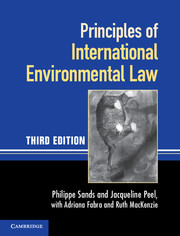Book contents
- Frontmatter
- Contents
- Foreword
- Preface and acknowledgments to the first edition
- Preface and acknowledgments to the second edition
- Preface and acknowledgments to the third edition
- Table of cases
- Table of treaties and other international instruments
- Abbreviations
- Part I The legal and institutional framework
- Part II Principles and rules establishing standards
- Part III Techniques for implementing international principles and rules
- Part IV Linkage of international environmental law and other areas of international law
- 18 Human rights and armed conflict
- 19 International trade and competition
- 20 Foreign investment
- 21 Future developments
- Index
- References
18 - Human rights and armed conflict
from Part IV - Linkage of international environmental law and other areas of international law
Published online by Cambridge University Press: 05 June 2012
- Frontmatter
- Contents
- Foreword
- Preface and acknowledgments to the first edition
- Preface and acknowledgments to the second edition
- Preface and acknowledgments to the third edition
- Table of cases
- Table of treaties and other international instruments
- Abbreviations
- Part I The legal and institutional framework
- Part II Principles and rules establishing standards
- Part III Techniques for implementing international principles and rules
- Part IV Linkage of international environmental law and other areas of international law
- 18 Human rights and armed conflict
- 19 International trade and competition
- 20 Foreign investment
- 21 Future developments
- Index
- References
Summary
INTERNATIONAL HUMAN RIGHTS
Introduction
International environmental law raises many issues that will be familiar to human rights lawyers. In the environmental context, questions related to minimum international standards and the role of individuals and other non-governmental organisations in the international legal process have raised analogous issues to those arising in international human rights law. The international legal issues are closely related, as is now reflected in the activities of human rights bodies. Allegations of civil rights breaches continue to abound in the environmental field, and have focused on a range of issues, from the suppression of environmental discussion and debate and of environmental campaigners, to restrictions on the right of association and assembly, as well as restrictions on rights of access to environmental information. Human rights issues increasingly arise in relation to ‘environmental refugees’ forced to flee areas because of drought or desertification (or future climate change), and humanitarian issues involving the use of force and the environmental impacts of war, which are considered in the second part of this chapter. In the 1980s, human rights issues related to environmental protection became the subject of increasing attention following a number of well-known cases, including the 1988 murder of the Brazilian union organiser Chico Mendes, restrictions on the provision of information to citizens of the Soviet Union following the accident at the Chernobyl nuclear power plant, and the limited availability of remedies for breaches of environmental standards and obligations under national legal systems. Against this background, the linkages between human rights and the environment are now widely recognised, as reflected in an increase in case law before human rights bodies, and the interplay between environmental and human rights norms has also been raised in the Aerial Herbicide Spraying case filed at the ICJ by Ecuador against Colombia. Of equal note has been the 1998 Aarhus Convention, which establishes formal participation and informational rights and affirms, in its Preamble, that ‘every person has the right to live in an environment adequate to his or her health or well-being’.
- Type
- Chapter
- Information
- Principles of International Environmental Law , pp. 775 - 798Publisher: Cambridge University PressPrint publication year: 2012



